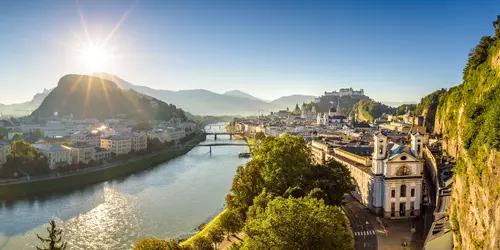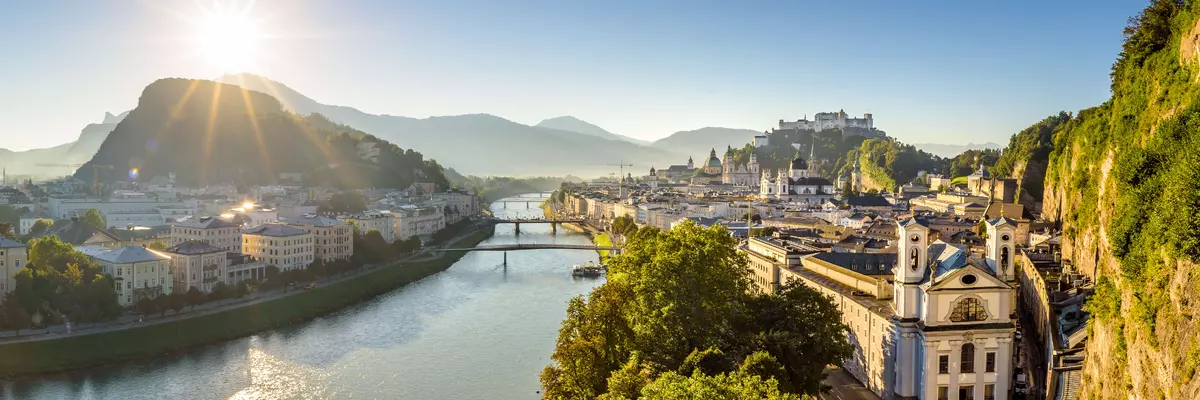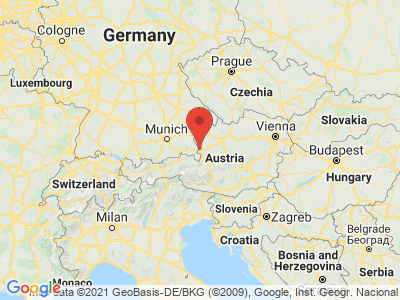Climate Table Salzburg
Jan | Feb | Mar | Apr | May | Jun | Jul | Aug | Sep | Oct | Nov | Dec | |
|---|---|---|---|---|---|---|---|---|---|---|---|---|
| Max. Temperature | 4° | 6° | 9° | 16° | 20° | 22° | 22° | 23° | 19° | 14° | 6° | 2° |
| Min. Temperature | -2° | -1° | 1° | 5° | 9° | 12° | 13° | 13° | 10° | 6° | 0° | -3° |
| Sun Hours | 3 | 4 | 4 | 5 | 7 | 6 | 7 | 7 | 6 | 4 | 2 | 2 |
| Rain Days | 8 | 10 | 14 | 11 | 11 | 13 | 12 | 6 | 11 | 14 | 11 | 11 |
The climate year of Salzburg
Salzburg, the capital of the Austrian province of the same name, is located only a few kilometers from the German border. The city is located on the northern edge of the Alps in the middle of the Salzburg Basin at an altitude of about 420 to 430 meters above sea level. Characteristic for Salzburg are the river Salzach and the city mountains. To the left of the Salzach rise the Festungsberg, Mönchsberg and Rainberg, while on the right bank of the river are the Kapuzinerberg and the somewhat smaller Bürglstein. Also in the Salzburg basin are the Morzger Hügel, the Hellbrunner Berg and the small Grafenhügel. The climate in Salzburg is temperate: summers are relatively mild, winters cold. Characteristic are the high amounts of precipitation compared to other Austrian cities. Strong winds also occur frequently. The location in the Salzburg basin often leads to fog.
General information about Salzburg
Salzburg is the birthplace of composer Wolfgang Amadeus Mozart. The inhabitants are proud of their most famous son, which is why Salzburg bears the epithet "Mozartstadt" and the official name of the airport is "Salzburg Airport W. A. Mozart". Salzburg also has much to offer culture lovers. Every summer, the Salzburg Festival takes place. The old town of Salzburg with its numerous ecclesiastical and secular buildings was designated a UNESCO World Heritage Site in 1996. The Hohensalzburg Fortress is the largest completely preserved castle in Central Europe. Just like Hellbrunn Palace, Mirabell Palace and other castles, it attracts numerous visitors every year. The diverse shopping opportunities leave nothing to be desired. If you visit Salzburg in the winter months, you should visit the Christmas markets. Winter sports enthusiasts will find a variety of opportunities in the surrounding area.
Tourism Salzburg
Already in October, winter is ushered in in Salzburg. Temperatures drop to just above freezing. In November, but no later than December, they fall below freezing for the first time. January is considered the coldest month in Salzburg. The cold period continues in February and can extend into March. However, the sub-zero temperatures in the winter months are sometimes interrupted by foehn weather. This causes relatively mild temperatures and long-distance visibility. In the spring months of April and May, the mercury column of the thermometer also climbs in Salzburg: the temperatures in this season are often in the double digits. The summer months of June, July and August are the warmest in Salzburg. In the past, several heat records have been set there. September is still quite mild in Salzburg, while in October you should dress warmer again.
The amount of precipitation in Salzburg is relatively high compared to the rest of Austria, with about 1350 millimeters per year. The prolonged rainfall, which hits the city mainly in the summer months, is notorious among locals and tourists as the "Salzburger Schnürlregen". Its cause lies in Salzburg's location on the northern edge of the Alps: the moist air masses from Central Europe get stuck on the mountains and form rain clouds. This has definite advantages, especially in summer, because a warm morning, a hot afternoon and a sultry eve are often followed by a refreshing thunderstorm in the evening hours.


